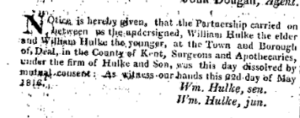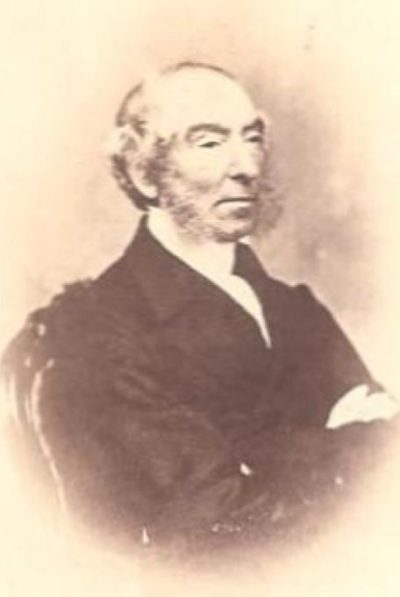William Hulke
Carmarques, Lower Street
Occupation: Surgeon
Born in Deal in 1791 William trained in London, then spent a year in Edinburgh and apparently spent some time in Paris too. He became a Member of the Royal College of Surgeons in 1814 and by 1815 he was in practice with his father in Deal.
Criminal Conversation
It was during 1815 that he started an affair with Lady Elizabeth Owen who was ten years his senior and the wife of Sir Edward William Cambell Richard Owen. This adulterous affair led to the Sheriffs Court in Bedford Row, London and William being prosecuted for ‘criminal conversation’ with Lady Owen.
On 22 May 1816, William Hulke senior, either very displeased with his son or protecting his business, decided to dissolve the short-lived partnership with his son.
The Sheriffs Court
At the Sheriffs Court witnesses were called to give evidence. Deal Solicitor John May and The Reverend John Davis, who had ‘celebrated’, in December 1802, the marriage between the then Elizabeth Cannon to Sir Edward Owen at St. Leonard’s Church in Deal, were amongst the first to be called. As proof of the marriage, they had brought with them a copy of the Parish’s Register of Marriages.
Mary Rigden, a Housemaid in the service of Sir Edward and Lady Owen, was also called. She gave evidence stating that while Sir Edward was in America Lady Owen stayed at Deal and that the ‘young’ Mr. Hulke often visited the house and “…at all times of the day…” often staying until “...Half past three in the morning….. In the Drawing-room.” She was asked if ‘young’ Mr. Hulke had supper with Lady Owen, and in what room, and at what time? She answered saying that yes they had supper together in her lady’s bedroom between ten and eleven at night! She also said that she had carried letters between the two lovers.
Another maidservant, Elizabeth Banks, was then called to be examined.
She explained how in September 1815 that the ‘young’ Mr. Hulke visited Lady Owen, who was supposedly ill in bed. Elizabeth was asked, “Perhaps you had the curiosity to endeavour to look through the keyhole?” her reply was ” yes” but that she “….couldn’t see anything as there was a handkerchief covering the keyhole!”
Elopement
A plan of elopement was also proved, and the fact that Sir Edward had been informed of this by a servant and Sir Edward “….anxious to rescue her from ruin …” then sent this trusted servant after his wife to, “…save her from the misery…” that being connected with ‘young’ William would bring on her.
Once the servant found the lovers, he warned the ‘young’ Mr. Hulke that Sir Edward would soon arrive and according to this servants testimony, he replied “I don’t care ….I have two pistols …and if he comes, I will shoot him”
No explanation is given to tell us when or how Lady Elizabeth returned to her husband, but she did.
As for the ‘young’ William for his ‘Criminal Conversation’ with Elizabeth Owen, he had to pay £1,500 in Damages, plus the Cost of the Suit. In todays money that is about £87,000.
For Elizabeth there was no happy ending as the following year Sir Edward applied for a divorce, and as at this time this required an Act of Parliament, the whole story was again relayed in the House of Lords.
The divorce was granted and given Royal assent on 16 June 1817.
Lady Elizabeth Owen died in London eight years later and was buried on 7 June 1824 in the family vault in St. George’s Cemetery which still stands today.
 That he lost no time in getting his life in order is clear. He married Elizabeth Pollard King in 1819, and the couple went on to have thirteen children. He again went into partnership with his father, though this was later dissolved in 1832, this time it was by mutual consent probably as the elder William had decided to retire.
That he lost no time in getting his life in order is clear. He married Elizabeth Pollard King in 1819, and the couple went on to have thirteen children. He again went into partnership with his father, though this was later dissolved in 1832, this time it was by mutual consent probably as the elder William had decided to retire.
Seemingly the scandal of his affair was forgiven if not forgotten as by the early 1840s he was to become the “surgeon-apothecary in daily attendance” upon the Royal children while they stayed at Walmer Castle, as well as surgeon to The Duke of Wellington when he too was in residence there as Lord Warden of the Cinque Ports.
Bankruptcy
William’s father in 1808, with partners John Hollams, John Sampson and John Iggulden, established the private bank, Hulke & Co. It was also known as the Deal, Naval and Military Commercial Bank. By 1827 it had become Hulke, Sons and Dixon. John East Dixon, who had married Ann Hulke, William’s sister, in 1830 The bank by the end of the 1830s was in financial trouble and in 1840, following bankruptcy, it was acquired by The National Provincial Bank of England which later became the National Westminster Bank.
After the birth of his last child, in 1842, William was honoured by a communication from the Queen ‘desiring’ that he should call his newborn son Victor. Then a few days later while attending the Royal Family at Walmer Castle, the two-year-old Princess Victoria gave him a gold pencil case supposedly saying “give this to Victor as a present from me”
On the morning of 14 September 1852 William and his son John were called to attend the Duke of Wellington. Later that day they were again called to the Duke. Sadly this was to be to witness the death of the Duke of Wellington.
On a visit to the Kent History and Library Centre, we found a letter from William to an unnamed Lord. As William sends his “…respects to lady Delawar…” and, the letter is amongst the Sackville papers we are assuming that the ‘Lord’ is George Sackville-West, 5th Earl De La Warr. The letter is
William continued to serve the people of Deal in both happy and sad occasions. As is the case today, it is often the sad occasions that make it into newspapers. One such occasion was when he was called, by Mrs. Backhouse of Prospect Place in 1857, to the suicide of her cook Sarah Belsey who had slit her own throat while her mistress was out. Another time, in 1861, he was called to attend the five-year-old daughter of George Wellard at Great Mongeham. She had been crushed while playing in their yard by a 4 cwt beer cooler.
William died in January 1866 and is buried in the family vault in St. Leonard’s Church. His obituary in the Deal, Walmer & Sandwich Telegram tells us of his life and that, on at least one occasion, he found himself fired upon by smugglers.
Elizabeth, his wife, and their spinster daughters continued to live in Carmarques, the family home on Lower Street, which still stands today.


